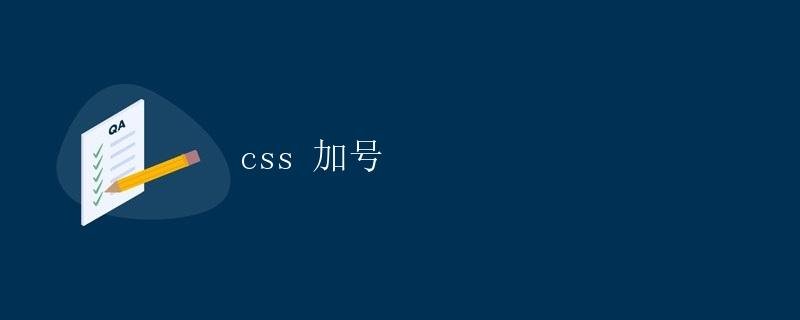CSS Plus Sign
CSS Plus Sign

1. Introduction
In web development, we often need to adjust the layout and style of elements. CSS (Cascading Style Sheets), a commonly used style description language, offers a rich set of selectors and properties, allowing users to achieve a variety of cool effects using simple syntax.
This article will focus on the plus sign (+) selector in CSS and explain its usage and application scenarios with sample code.
2. Basic Usage of the Plus Selector
The plus selector is a CSS selector used to select the immediately following sibling elements of a specified element. Its syntax is:
element1 + element2 {
style attribute: value;
}
Where, element1 and element2 represent two adjacent elements, which can be specific tag names, class selectors, ID selectors, etc.
Using the plus selector, you can select the first adjacent element 2 after element1, and only that adjacent element 2 will be applied with the specified style.
The following code example shows how to use the plus sign selector to style adjacent elements:
<!DOCTYPE html>
<html>
<head>
<style>
p + div {
background-color: yellow;
}
</style>
</head>
<body>
<p>This is a paragraph. </p>
<div>This is a DIV element. </div>
<div>This is another DIV element. </div>
</body>
</html>
The output is as follows:
This is a paragraph.
[Yellow background]This is a DIV element.
This is another DIV element.
As you can see, the plus sign selector selects the first adjacent <div> element after the <p> element and sets its background color to yellow.
3. Application Scenarios of the Plus Selector
3.1 Layout of Adjacent Sibling Elements
The plus selector is often used to adjust the layout of adjacent sibling elements. By setting the style of the first element, you can affect subsequent adjacent elements.
For example, you can use the plus sign selector to create a simple navigation bar effect. Links in the navigation bar are selected using the plus sign selector’s adjacent relationship, and styles are set to create a separation effect between the links.
<!DOCTYPE html>
<html>
<head>
<style>
a {
color: blue;
text-decoration: none;
}
a + a {
margin-left: 10px;
padding-left: 10px;
border-left: 1px solid black;
}
</style>
</head>
<body>
Home
Products
Services
About Us
</body>
</html>
The results are shown below:
[Home] | [Products] | [Services] | [About Us]
As you can see, using the plus sign selector to style the links in the navigation bar creates a vertical line between them.
3.2 Styling Specific Locations
The plus sign selector can be used to style elements at specific locations. By selecting the adjacent elements after the first one, you can differentiate the styles of elements at different locations.
For example, you can use the plus sign selector to style the text label of an input field so that it appears bold when the field is focused.
<!DOCTYPE html>
<html>
<head>
<style>
input:focus + label {
font-weight: bold;
}
</style>
</head>
<body>
<input type="text" placeholder="Please enter your name">
<label>Name</label>
</body>
</html>
The running result is shown below:
[Input box] [Name]
As you can see, when the input box receives focus, the font of the name label becomes bold.
4. Notes on the Plus Selector
While the plus selector is very useful in certain scenarios, it’s important to keep in mind the following points:
- The plus selector only selects the first adjacent element and has no effect on subsequent adjacent sibling elements.
- If there are other elements between adjacent sibling elements, the plus selector will not work on those elements.
- The plus selector only selects immediately adjacent sibling elements and excludes sibling elements at other locations.
5. Conclusion
This article detailed the basic usage and application scenarios of the plus selector in CSS. By selecting adjacent sibling elements, you can adjust the style and layout of specific locations. The plus selector is very useful in web development. I hope this article will provide readers with a deeper understanding and application of it.
By learning the plus sign selector, we can better understand how to use selectors in CSS, improve web page layout and styling, and provide a better user experience.